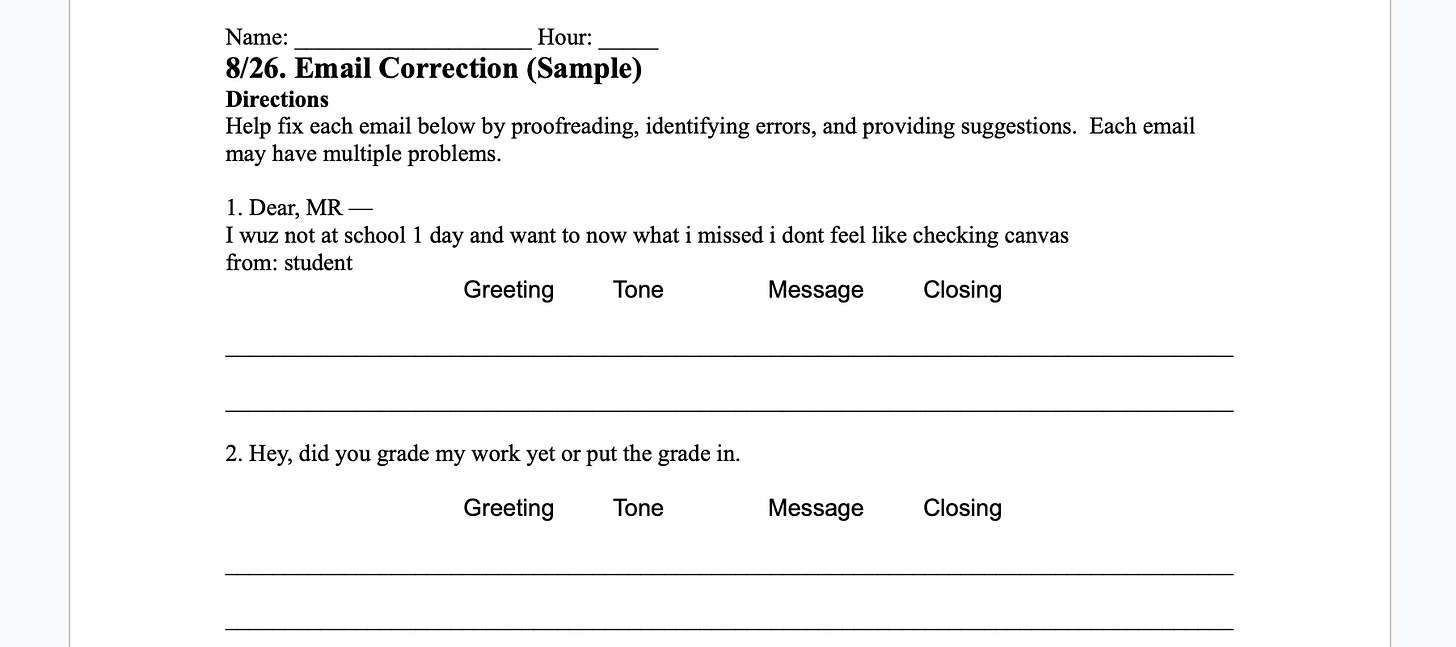✏️ Practice Writing Rules by Breaking Them (+ FREE Template)
This rainy day activity will create endless (hilarious) teaching examples.
Ready for a rainy day activity sure to bring laughs? Ready for authentic, student-generated responses that work? What if students proved they know rules by… breaking them?
🎩 The Big Picture. Rule breaking activities have two parts: Breaking rules and narrating how. That’s it. Show and tell, write and explain. Google Forms Discussions allow real time feedback while examples recycle as future review or worksheet examples. Best of all? Students will naturally compete for the silliest mistakes.
🌎 Zoom Out. Sequence “rule breaking” after learning and practicing a skill. I prefer the following progression:
Mini-Lesson. Explicit instruction on the concept.
Practice. Follow up writing activities.
Rule Breaking. Review and student-generated examples.
Review or Activity Sheet. Discuss or critique student-generated examples.
Where does this work best? Ask a different question: Where do you need more practice and examples? Just spend 5-10 minutes crowdsourcing and generate dozens of examples. Even if they’re not perfect, they provide easy starting points to write your own.
⚙️ How It Works. The discussion activity itself has three basic parts:
Step 1. Review. Begin with some retrieval practice to describe the task. (5 min.)
Step 2. Write. Students must break the rule and narrate the rule broken. (5 min.)
Step 3. Discuss. Whole class discussions critiquing and suggesting improvements. (10 min.)

💡 Google Forms Tip! Consolidate Google Forms Discussions into one yearly document. This archives hundreds or thousands of examples into one place!
🤔 Yes, But. "This seems like a waste of time. Doesn't purposely breaking rules reenforce the opposite? Doesn't perfect practice make perfect? How will breaking rules help?"
Show and Tell. If students can show how and explain why they broke a given rule, then they understand.
⭐️ Terribly Efficient. Never doubt the power of terrible examples. When mixed (interleaved) properly, they become powerful and concise review tools. Fixing ten examples with ten different mistakes fosters rapid improvements.
➡️ Why It Works. Rule breaking discussions tap into basic kid psychology: They will compete to be funny. And they will error in unpredictable ways! If you fear actual bad responses going unnoticed, just read the narration section carefully.
🎉 Fun Examples. This year students wrote bad emails twice—once in the fall and once in the spring. The following were inspired by those examples. I’ll use two slashes (//) to indicate line breaks.
Email #1. Dear, MR — // I wuz not at school 1 day and want to now what i missed i dont feel like checking canvas // from: student
Email #2. Hey, did you grade my work yet or put the grade in.
Email #3. i hav a question on a assignment
Email #4. To: Mr. — // i have a question on me home work sencerly [student]
Email #5. Mr — // how do u do number 4 on yesterdays work i was sick from student
Note: For context, I talk with my students about avoiding obvious questions and narrating what you’ve tried first. They know these messages stink.
In Action. Since Google Forms collects and compiles, this leaves curation. While I may not use examples verbatim, they often inspire specific examples for specific critiques. See the examples below.
As Discussion: A slide with 5-6 examples becomes a quick review activity. Rewriting examples to address certain errors directs the feedback where I see issues.
As Worksheet: Reversing the polarity works wonders: Students still have to identify the rule broken, but now they have to offer critique as well.
💰 Cost. Did I mention these custom-made, student-inspired examples are free?
✅ Next Steps. What skills do you want to reenforce? Where would crowdsourcing examples help? In the meantime, I'll post my example for ideas and a template so you can try. Just Make a copy!
📚Go Deeper. Student writing helps students write. Google Forms allow real time feedback and easy archiving. Together, collecting, compiling, and curating student writing provides the means for rapid improvements. The best part? It's free! Check out some related posts:
Three Big Benefits to Teaching with Student Writing (9/2024)
Google Forms for Teachers: A Primer (5/2025)
How Google Forms Automate Grading (6/2025)
🎁 New to the blog? Check out my recent starter pack as well as a Google Drive Folder with FREE classroom resources! Also, The Honest School Times has your schooling satire.
🏆 Fan Favorites
✏️ Teach Writing Tomorrow




